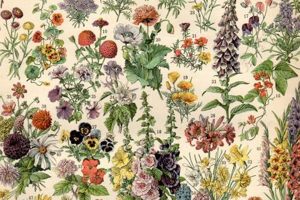The period between the late 19th century and World War I, known for its optimism, peace, and flourishing arts and culture, produced a wealth of visual art, including vibrant advertisements printed on paper. These artifacts offer a tangible connection to a bygone era. Preservation and presentation of these historical documents often involves techniques designed to protect their integrity while enhancing their aesthetic appeal. This combination of historical artifact and preservation methods constitutes a unique area of collecting and art appreciation.
These printed artworks are significant because they reflect the artistic styles, commercial developments, and societal values of the era. They provide insights into the evolution of graphic design, advertising strategies, and the cultural trends that shaped modern society. Skillful preservation ensures their survival for future generations, allowing continuous appreciation and study. Careful display highlights the aesthetic qualities and contextual importance, enriching the viewer’s understanding and experience.
The following discussion will examine various aspects of these historical artifacts, exploring their artistic features, their significance as cultural artifacts, and the best practices for ensuring their longevity and presentation through appropriate techniques. These elements encompass authentication, restoration considerations, selection of appropriate mounting methods, and choosing suitable materials for display environments.
Guidance on Acquiring and Maintaining Historical Paper Advertisements
The acquisition and care of vintage advertising prints require a discerning eye and a commitment to preservation best practices. The following guidelines aim to assist collectors and enthusiasts in making informed decisions.
Tip 1: Authentication is Paramount. Prior to purchase, confirm the print’s authenticity. Seek expert opinions and compare the print to known originals. Scrutinize printing techniques, paper quality, and any identifying marks unique to the period. Consult reputable dealers and auction houses specializing in these artworks.
Tip 2: Assess Condition Meticulously. Examine the print under proper lighting for signs of damage, including tears, fading, foxing (brown spots), and water stains. The condition significantly impacts the value and long-term preservation requirements. Lower prices for damaged items may be offset by costly restoration.
Tip 3: Prioritize Archival Materials. Opt for acid-free and lignin-free materials when mounting and displaying. These materials prevent deterioration by neutralizing harmful chemicals present in standard paper products. Archival-quality matting and backing boards are essential.
Tip 4: Glazing Considerations are Crucial. Utilize UV-filtering glazing materials, such as museum glass or acrylic, to minimize light damage. Prolonged exposure to ultraviolet light causes fading and embrittlement. Ensure the glazing provides an adequate seal to protect against environmental contaminants.
Tip 5: Environmental Controls are Necessary. Maintain stable temperature and humidity levels in the display environment. Fluctuations can cause paper to expand and contract, leading to warping and cracking. Aim for a temperature range of 65-75F (18-24C) and a relative humidity of 45-55%.
Tip 6: Proper Mounting Techniques. Avoid adhesives directly on the print. Employ archival-safe mounting corners or strips to secure the print within the mat. Ensure the mounting method allows for natural expansion and contraction of the paper. Pressure-sensitive tapes should be avoided at all costs due to their long-term degradation.
Tip 7: Professional Restoration When Needed. For significant damage, consider consulting a professional paper conservator. Attempting repairs without expertise can cause further harm. A qualified conservator can stabilize the print, reduce staining, and repair tears using appropriate methods and materials.
Adherence to these recommendations enhances the enjoyment and value of these historical artworks while ensuring their availability for future generations. Diligence in authentication, condition assessment, and preventive conservation forms the cornerstone of responsible collecting.
The next section will address advanced conservation techniques and considerations for long-term preservation strategies.
1. Artistic Style
The artistic styles prevalent during La Belle poque profoundly influenced the aesthetic character of the printed advertisements of the era. These distinctive visual approaches not only served as powerful marketing tools but also reflected the broader cultural and artistic movements shaping society.
- Art Nouveau’s Influence
Characterized by organic, flowing lines, curvilinear forms, and stylized depictions of nature, Art Nouveau dominated the visual landscape. This style permeated the design of advertisements, imparting an elegant and sophisticated aesthetic. Artists like Alphonse Mucha employed Art Nouveau principles, creating posters featuring graceful female figures intertwined with floral motifs. Its application provided products and services a sense of luxury and modernity.
- The Rise of Lithography
The development of chromolithography enabled the mass production of colorful and visually striking prints. This technique allowed for the creation of richly detailed illustrations and vibrant color palettes, previously unattainable in print advertising. Artists leveraged chromolithography to produce eye-catching advertisements that captured the attention of a growing consumer culture. Jules Chret’s innovative use of color and composition is representative of this advancement.
- Japanese Art Influences (Japonisme)
The incorporation of Japanese artistic elements, such as flattened perspective, bold outlines, and asymmetrical compositions, gained traction among artists. This influence, known as Japonisme, introduced a fresh perspective to advertising design. The use of simplified forms and a focus on decorative patterns characterized a departure from traditional Western art conventions. Toulouse-Lautrec’s poster designs demonstrate the effective integration of Japonisme principles.
- Symbolism and Evocative Imagery
Beyond mere product representation, advertisements adopted symbolic imagery to evoke emotions and create associations in the consumer’s mind. This approach utilized metaphors, allegories, and dreamlike scenarios to convey messages. The creation of atmosphere and the generation of desire transcended basic product information, enhancing the advertising’s psychological impact. This approach aimed for lasting impression and brand recognition through suggestion and implication rather than direct sales pitches.
These artistic styles significantly shaped the look and feel of the printed advertisements from La Belle poque. They not only enhanced the visual appeal but also acted as cultural markers, reflecting the artistic trends and societal values of the period, making these advertisements valuable historical documents and works of art.
2. Historical Context
Understanding the historical context of printed advertisements from La Belle poque is essential for appreciating their cultural and artistic significance. These artifacts reflect the social, economic, and technological transformations of the era, providing valuable insights into the values, aspirations, and anxieties of the time.
- Technological Advancements and Mass Production
The late 19th and early 20th centuries witnessed rapid advancements in printing technology, particularly the development of chromolithography. This innovation enabled the mass production of vibrant, colorful posters at relatively low costs, making advertising accessible to a wider range of businesses and industries. The availability of inexpensive, visually appealing posters fueled a surge in commercial advertising, transforming the urban landscape and contributing to the growth of consumer culture. For example, companies such as bicycle manufacturers or department stores were able to widely advertise their products, creating a boom for graphic artists.
- The Rise of Consumer Culture and Urbanization
La Belle poque coincided with a period of increasing urbanization and the rise of a middle class with disposable income. This created a burgeoning consumer market eager for new products and experiences. Posters played a crucial role in shaping consumer desires and promoting brand awareness. As cities grew and public spaces became more populated, these printed artworks became a prominent feature of the urban environment, vying for attention and influencing purchasing decisions. Travel posters, for instance, promoted tourism to newly accessible locations due to railroad expansions.
- Artistic Movements and Cultural Influences
The artistic styles prevalent during La Belle poque, such as Art Nouveau and Japonisme, profoundly influenced the visual aesthetics of advertising. Artists incorporated these styles into their designs, creating posters that reflected the era’s artistic sensibilities and cultural values. The use of elegant, flowing lines, stylized imagery, and exotic motifs added a touch of sophistication to advertising, appealing to the refined tastes of the era’s consumers. The works of Toulouse-Lautrec, influenced by the styles mentioned, reflect this intersection of art and commercialism.
- Social and Political Dynamics
Posters served not only as commercial advertisements but also as vehicles for social and political messaging. Political campaigns, social movements, and nationalistic sentiments were often promoted through posters, reflecting the era’s social and political dynamics. These printed artworks offer a glimpse into the prevailing ideologies, anxieties, and aspirations of the time, providing valuable insights into the social fabric of La Belle poque. The Dreyfus Affair, for example, prompted poster campaigns on both sides of the contentious issue.
By understanding these historical facets, one gains a deeper appreciation for these vintage artworks. They are not merely commercial promotions but rather artifacts reflecting the technological advancements, cultural influences, and social dynamics that shaped La Belle poque. Their preservation and study offer valuable insights into the past, enriching our understanding of the era’s complexities and lasting legacy.
3. Print Condition
The state of preservation critically influences the value and aesthetic appeal of vintage posters. Damage, such as tears, staining, fading, or foxing, diminishes the artwork’s visual impact and reduces its market value. The fragility of paper-based artifacts from this period necessitates meticulous evaluation and, often, restorative intervention. A poster exhibiting vibrant colors, intact edges, and minimal blemishes represents a more desirable and historically accurate representation of the original artwork than one exhibiting significant degradation. For example, a poster by Toulouse-Lautrec, if found in pristine condition, can command a significantly higher price than a similar poster exhibiting substantial wear and tear, even after professional restoration.
The choice of preservation and presentation techniques is directly influenced by the print’s condition. Posters in relatively good condition may require only archival mounting and UV-protective glazing to ensure long-term stability. However, posters exhibiting significant damage may necessitate professional conservation treatments, such as paper repair, stain reduction, and lining, before display. The level of intervention must be carefully considered, balancing the desire to restore the artwork’s original appearance with the need to preserve its historical integrity. Overtreatment can be as detrimental as neglect, potentially altering the artifact’s authenticity and reducing its value. Conservation efforts should aim to stabilize the artifact and mitigate further deterioration while respecting its age and history. A heavily damaged poster may be best preserved through careful storage rather than aggressive restoration.
In summary, the state of preservation is a primary determinant of the value, aesthetic impact, and preservation requirements. Recognizing the specific types and extent of damage is crucial for making informed decisions regarding conservation, display, and long-term care. Prioritizing preventive measures, such as appropriate environmental controls and archival materials, is essential for minimizing future deterioration and ensuring the continued enjoyment and appreciation of these artifacts. Collectors and enthusiasts must balance the desire for visual appeal with the imperative of ethical conservation, recognizing that the primary goal is to safeguard these valuable pieces of cultural history for future generations.
4. Archival Quality
The preservation of ephemeral artifacts from La Belle poque, specifically printed advertisements, hinges critically on the concept of archival quality. The materials used in both the preservation and display processes can either ensure the longevity of these historical documents or, conversely, contribute to their accelerated deterioration. The inherent acidity present in many common paper products, coupled with environmental factors like light and humidity, poses a significant threat to the cellulose fibers that comprise these artworks. Inferior materials, such as non-acid-free matting or backing boards, transfer harmful acids to the poster, leading to embrittlement, discoloration, and eventual disintegration. For example, mounting an original advertisement with standard cardboard backing, a common practice in the past, invariably results in irreversible damage over time.
The application of archival principles extends beyond the choice of paper products to encompass adhesives, glazing, and display methods. Adhesives must be acid-free and reversible, allowing for future removal without causing damage to the paper. Glazing materials should incorporate ultraviolet (UV) filters to mitigate light-induced fading and degradation. Display environments require careful control of temperature and humidity to minimize fluctuations that can stress the paper fibers. Archival mounting techniques, such as using acid-free corners or strips to suspend the poster within a mat, avoid direct contact with adhesives, allowing the paper to expand and contract naturally with changes in environmental conditions. These preventive measures, when implemented comprehensively, create a protective barrier against the factors that contribute to the degradation of these historically significant materials. The long-term stability of the poster is therefore directly correlated with the archival quality of the materials and techniques employed in its preservation and display.
In conclusion, archival quality is not merely an abstract concept but a practical imperative for the ethical and responsible preservation of printed artifacts from La Belle poque. The selection of appropriate materials and techniques, guided by the principles of archival conservation, is essential for safeguarding these historical documents for future generations. Challenges remain in identifying and mitigating the long-term effects of previously used non-archival materials and in educating collectors and enthusiasts about the importance of archival best practices. However, by prioritizing archival quality, we ensure that these tangible links to the past continue to inform and inspire future generations.
5. Display Environment
The surrounding conditions within which printed artifacts are presented and stored constitute a critical factor in their long-term preservation. Inappropriate ambient conditions accelerate degradation, diminishing their aesthetic appeal and historical value. Specifically, the conservation of these unique artworks requires careful management of several environmental variables.
- Light Exposure
Prolonged exposure to light, particularly ultraviolet (UV) radiation, induces photochemical reactions that cause fading, discoloration, and weakening of paper fibers. Direct sunlight and fluorescent lighting are particularly damaging. Museums and archival institutions utilize UV-filtering glazing materials and restrict light levels to minimize these effects. Rotating displays and storing sensitive artifacts in dark environments when not exhibited also mitigate light damage. Improper light management leads to irreversible fading of colors and text, diminishing the visual impact and informational content of the item.
- Temperature and Humidity
Fluctuations in temperature and relative humidity cause paper to expand and contract, leading to warping, cracking, and embrittlement. High humidity promotes mold growth and insect infestation, while low humidity causes the paper to become brittle. A stable environment with a temperature range of 65-75F (18-24C) and a relative humidity of 45-55% is generally considered optimal for paper conservation. Climate-controlled storage and display areas are essential for minimizing the risk of environmental damage. Failure to maintain stable temperature and humidity levels can result in significant and irreversible damage to these fragile artworks.
- Air Quality and Pollutants
Airborne pollutants, such as dust, smoke, and acidic gases, contribute to the deterioration of paper. Dust particles abrade the surface, while acidic pollutants react with the cellulose fibers, causing discoloration and weakening. Air filtration systems and regular cleaning are necessary to maintain good air quality in display and storage areas. Framing posters behind sealed glazing helps to protect them from airborne pollutants. Neglecting air quality control can accelerate the degradation process, leading to irreversible damage and loss of historical information.
- Mounting and Framing Materials
The materials used for mounting and can also affect their long-term stability. Acidic matting and backing boards cause discoloration and embrittlement of the paper. Archival-quality, acid-free materials should be used for all mounting and framing components. Proper mounting techniques, such as using archival corners or strips to suspend the poster within the frame, allow for natural expansion and contraction of the paper and prevent direct contact with adhesives. The selection of inappropriate mounting materials can lead to significant and irreversible damage, even in otherwise well-controlled environments.
The careful management of each environmental element is crucial for the long-term stability and preservation of these historical artifacts. Neglecting any of these factors compromises their integrity and diminishes their value. A comprehensive approach to environmental control, incorporating appropriate lighting, temperature, humidity, air quality, and mounting materials, is essential for ensuring their survival for future generations.
6. Conservation Methods
The application of specific conservation methods is paramount to maintaining the integrity and prolonging the lifespan of La Belle poque vintage posters, especially when considering the potential value in quality framing. These artifacts, inherently fragile due to their paper composition and age, are susceptible to a variety of degradation processes. The effectiveness of applied techniques directly impacts the artifact’s long-term survival and continued accessibility for study and appreciation. For example, the use of deacidification treatments neutralizes the harmful acids that accumulate within the paper fibers, mitigating embrittlement and discoloration. Without such interventions, the paper becomes increasingly brittle, making it vulnerable to tearing and disintegration. The choice of framing methods, such as using archival-quality materials and UV-protective glazing, serves as a preventative conservation measure, shielding the artwork from environmental damage.
Restorative interventions address existing damage and stabilize the artifact for future preservation. Techniques such as tear repair, stain reduction, and lining provide structural support and improve the aesthetic appearance of the print. However, such interventions must be undertaken with caution and by qualified conservators to avoid causing further harm. For example, the improper use of adhesives or solvents can result in irreversible damage to the paper fibers or the original printing inks. The goal of restorative conservation is not to make the artifact appear new, but rather to stabilize its condition and preserve its historical integrity. Appropriate documentation of all conservation treatments is essential, providing a record of the interventions undertaken and facilitating future preservation efforts. The careful selection of framing techniques that complement the conservation efforts ensures both protection and aesthetic enhancement. Quality framing not only preserves the poster but also presents it in a manner that highlights its artistic and historical significance.
Ultimately, the effective implementation of conservation methods is indispensable for ensuring the continued existence of La Belle poque vintage posters. These actions safeguard a tangible connection to a transformative period in art, culture, and commerce. Challenges persist in balancing the desire to restore the artwork to its original appearance with the imperative of preserving its historical character. The ongoing development of new conservation techniques and the training of qualified conservators are crucial for addressing these challenges and ensuring that these pieces of history remain accessible for future generations. Furthermore, the investment in quality framing serves as a final and critical step in presenting and preserving these cultural treasures, enhancing their value and ensuring their longevity.
Frequently Asked Questions
The following addresses common inquiries regarding the acquisition, preservation, and presentation of authentic printed advertisements from the late 19th and early 20th centuries.
Question 1: What defines an “authentic” La Belle poque vintage poster?
Authenticity is established through several criteria. It involves verifying the printing technique (typically lithography or chromolithography), examining the paper type and age, comparing the image to known originals, and assessing provenance (history of ownership). Consultation with experts in vintage poster authentication is advisable prior to purchase.
Question 2: Why is archival quality framing essential for these posters?
Acidic materials in standard framing components accelerate paper degradation, leading to discoloration and embrittlement. Archival-quality framing utilizes acid-free materials, UV-filtering glazing, and reversible mounting methods, protecting the poster from environmental damage and ensuring its long-term preservation.
Question 3: What are the primary causes of deterioration in these printed artworks?
The primary causes include exposure to ultraviolet (UV) light, fluctuations in temperature and humidity, airborne pollutants, and acidic materials in contact with the paper. These factors induce photochemical reactions, weakening of paper fibers, and promoting mold growth, ultimately resulting in damage.
Question 4: Can damaged La Belle poque vintage posters be restored?
Yes, professional paper conservators employ various restoration techniques, including tear repair, stain reduction, and lining, to stabilize and improve the appearance of damaged posters. However, restoration should be undertaken with caution to avoid over-treatment and maintain the artifact’s historical integrity. The extent of restoration should be commensurate with the poster’s value and condition.
Question 5: How should these framed artworks be displayed to minimize deterioration?
Display these artifacts away from direct sunlight and sources of heat or humidity. Maintain stable temperature and humidity levels in the display environment. Utilize UV-filtering glazing to protect against light damage and consider rotating displays to minimize prolonged exposure. Wall mounting is advised to avoid accidental damage.
Question 6: What are the ethical considerations in collecting and displaying these artifacts?
Ethical considerations involve ensuring the poster’s provenance is legitimate, avoiding the purchase of illegally obtained or reproduced items, and prioritizing preservation over aesthetic alteration. Conservation treatments should be reversible and fully documented. Respect for the historical and cultural significance of the artifact should guide all decisions.
Proper authentication, archival framing, appropriate display environments, and ethical considerations collectively ensure the longevity and appreciation of these historical treasures.
The subsequent section addresses advanced preservation strategies for safeguarding these artifacts for future generations.
Conclusion
The preceding exploration has elucidated the multifaceted aspects of la belle epoque vintage posters & framing, from the intricacies of authentication and the significance of artistic style to the critical role of archival preservation and appropriate display environments. Understanding the historical context, assessing print condition, and applying effective conservation methods are essential for safeguarding these artifacts. The integration of quality framing not only serves a protective function but also enhances the aesthetic value and ensures their continued appreciation.
The ongoing commitment to responsible acquisition, diligent preservation, and informed presentation ensures that these tangible remnants of a transformative era remain accessible for future generations. The value lies not only in their artistic merit but also in their capacity to inform and inspire, offering a unique lens through which to view the cultural, social, and economic dynamics of a bygone age. Continued research, education, and adherence to ethical collecting practices are paramount to preserving this valuable cultural heritage.







